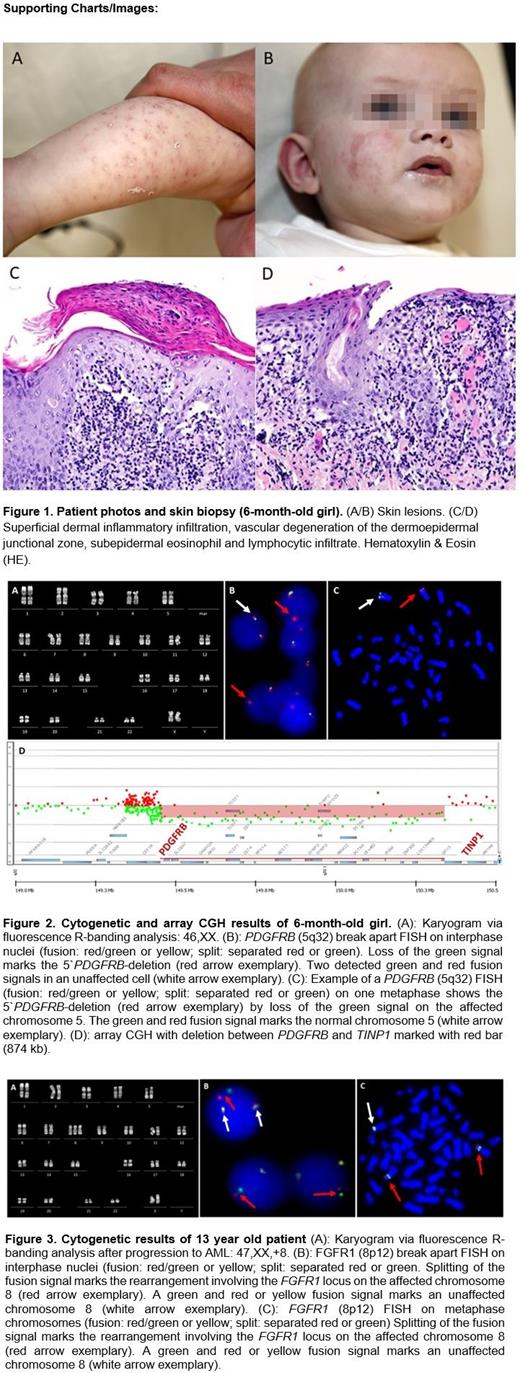Abstract

Introduction: MLN-eo associated with gene rearrangements of PDGFRA, PDGFRB, FGFR1, or PCM1-JAK2 are rare haematological neoplasms primarily affecting adults. Eosinophilia commonly occurs but may also be absent. The heterogeneous clinical picture and the rarity of the disease, especially in children, may delay an early diagnosis. MLN-eo are characterized by constitutive tyrosine kinase activity due to gene fusions. It is thus of prognostic importance to obtain a prompt genetic diagnosis to start a specific therapy.
Here we report two female paediatric cases of MLN-eo (6 months and 13 years old at initial diagnosis).
Methods: In both cases, bone marrow morphology, karyotyping, fluorescence in-situ hybridization analysis (FISH) via break apart probes (PDGFRB (5q32), FGFR1 (8p12), JAK2 (9p24), FIP1L1/CHIC2/PDGFRA (4q12)), targeted RNA sequencing and in one case array CGH were performed.
Results: The 6 months old girl was admitted to hospital with a 3-month history of rash and leukocytosis with eosinophilia. The skin showed multiple purpuric lesions (Fig 1 A/B). Mild splenomegaly was noted. White blood count (WBC) was 48000/µl with 38% eosinophils. Bone marrow trephine showed hypercellular marrow with mild fibrosis and eosinophilia without increase in blasts. Biopsy of a skin nodule displayed a histological pattern of interface dermatitis with eosinophilic infiltrate. (Fig 1 C/D). Fluorescence R-banding showed a normal karyotype (46,XX) (Fig. 2 A). However, FISH and array CGH detected an interstitial deletion of 5` PDGFRB (5q32) in 61 % of interphase nuclei (Fig. 2 B-D). Targeted RNA sequencing (RNA-seq) confirmed, as the array CGH suggested, the suspected TNIP1/PDGFRB fusion. According to the WHO criteria, diagnosis of a myeloid neoplasia with PDGFRB rearrangement due to an interstitial deletion in 5q was made. Because of the PDGFRB rearrangement, imatinib (250 mg/m²/d) therapy was started. Leukocyte and eosinophil counts normalized within 4 days without signs of tumour lysis. Skin lesions disappeared within 2 weeks. After 4 weeks, the dose was reduced to 100 mg/m² 3 x/week. Now at 14 months of age, peripheral counts continue to be normal and the fusion transcript is not detectable in the peripheral blood.
The 13 years old girl was admitted with severe tachypnoea due to pleural effusions, hepatosplenomegaly and lymphadenopathy. Echocardiography showed endocarditis, left ventricular fibrosis and mitral insufficiency. WBC was 112170 /µL with 39% eosinophils. Bone marrow aspirate and trephine showed a feature of myeloproliferative neoplasia (MPN) with eosinophilia. The karyotype was normal. A rearrangement involving the FGFR1 locus was detected by FISH (Fig. 3 B/C). Splitting of the probe signals indicated an inversion on chromosome 8. Targeted RNA sequencing revealed a PCM1-FGFR1 fusion transcript. Diagnosis of a MLN-eo with FGFR1 rearrangement and evidence of a PCM1-FGFR1 fusion, most likely caused by an inversion on chromosome 8, was made. The girl stabilized after therapy with prednisone, vincristine, hydroxycarbamide and anti-IL-5 antibody. Peripheral blood counts normalized within 2 weeks. Eight weeks after initial diagnosis she presented with signs of a transient ischemic attack, respiratory distress and arterial hypotension. At that time WBC was 139000/µl with 53% myeloid blasts and 5% eosinophils. Trisomy 8 was detected in all metaphases and 88% of cells in FISH (Fig.3 A-C). Diagnosis of a progression to a myeloid blast phase was made. Induction chemotherapy (cytarabine, idarubicin, etoposidphosphate) was administered. On day +22 bone marrow aspirates showed the persisting picture of MPN. Preparations for hematopoietic stem cell transplantation (HSCT) and ponatinib therapy were begun, but cardiac and respiratory insufficiency that developed during chemotherapy were fatal.
Conclusion: As these two cases have shown, standard cytogenetic and molecular methods may not be sufficient to diagnose MLN-eo due to cytogenetically cryptic aberrations. Thus, genetic diagnosis must be precise and quick (e.g. break apart FISH, targeted RNA-seq) in order to initiate adequate therapies with tyrosine kinase inhibitors or HSCT. Patients with rearrangements of PDGFRA or PDGFRB usually respond well to imatinib, whereas patients with FGFR1 and JAK2 gene fusions exhibit more aggressive diseases with variable sensitivity to tyrosine kinase inhibitors and have an early indication for HSCT.
Reiter: Novartis: Honoraria, Membership on an entity's Board of Directors or advisory committees, Other: Travel expenses, Research Funding; Blueprint Medicines: Honoraria, Membership on an entity's Board of Directors or advisory committees, Other: Travel expenses; Incyte: Membership on an entity's Board of Directors or advisory committees, Other: Travel expenses; AOP Orphan Pharmaceuticals: Honoraria, Membership on an entity's Board of Directors or advisory committees, Other: travel support; Deciphera: Membership on an entity's Board of Directors or advisory committees, Other: Travel expenses; Abbvie: Membership on an entity's Board of Directors or advisory committees; Celgene/BMS: Honoraria, Membership on an entity's Board of Directors or advisory committees, Other: travel support.
Author notes
 This icon denotes a clinically relevant abstract
This icon denotes a clinically relevant abstract


This feature is available to Subscribers Only
Sign In or Create an Account Close Modal